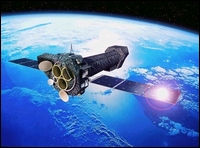
 |
Atmos C240B/C160: Remote Sensing |
|
C240B/C160. Remote Sensing. (4) Lecture, three hours.
Concurrently.
Requisites: courses C203C/C165 or instructor's
consent
Introduction to remote sensing based on the principle of radiative transfer; Atmospheric spectroscopy and spectral channels for atmospheric and surface remote sensing from space; Remote sensing of aerosols and ozone; Introduction of the Fredholm equation of the first kind and discussion of the direct and constrained linear inversions; Satellite remote sensing of temperature and humidity using the thermal emission principle in the infrared; Satellite remote sensing of clouds using reflection, polarization, and reflected line spectrum from sunlight; Satellite remote sensing of precipitation and temperature from microwave; Active lidar (laser radar) and millimeter-wave radar remote sensing of clouds and aerosols.
Textbook: An
Introduction to Atmospheric Radiation, Academic Press, 2002, Chapter 7;
additional references will also be provided.
Letter grades: students are required to carry out a numerical exercise involving the inversion of aerosol size distribution from radiometric measurements and to write a term paper on an aspect of remote sensing that interests them.
Outline of the course
- INTRODUCTION: meaning of remote sensing; uniqueness; active and passive; key milestones of atmospheric sounding from satellites
- REMOTE SENSING USING TRANSMITTED SUNLIGHT: determination of aerosol optical depth and size distribution; direct and constrained linear inversions; determination of total ozone concentration
-
REMOTE SENSING USING REFLECTED SUNLIGHT: satellite-sun geometry and theoretical foundation; satellite remote sensing of ozone, aerosols, and land surfaces; cloud optical depth and particle size from bidirectional reflectance, polarization, and reflected line measurements
-
REMOTE SENSING USING EMITTED INFRARED RADIATION: theoretical foundation; surface temperature determination; remote sensing of temperature profiles and cloud removal; remote sensing of water vapor and trace gas profiles; slicing technique for inferring cloud top pressure and emissivity
- REMOTE SENSING USING EMITTED MICROWAVE RADIATION: microwave spectrum and microwave radiative transfer; microwave remote sensing of rainfall rate and temperature
- REMOTE SENSING USING LASER AND MICROWAVE ENERGIES: backscattering equation; lidar differential absorption and depolarization techniques for the remote sensing of gases and aerosols; millimeter-wave radar for cloud study

